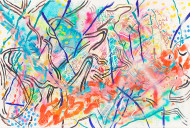
|
Nancy Graves Nancy Graves (artist) American, 1940 - 1995 Agualine, 1980 oil on canvas overall: 111.8 x 167.6 cm (44 x 66 in.) Collection of Robert and Jane Meyerhoff 2010.14.1 On View |
Throughout her career, Nancy Graves mined the world of natural science for her imagery, from meticulously constructed camels to detailed cartographic studies. Her dual interest in science and art started with childhood visits to the Berkshire Museum in Pittsfield, Massachusetts, where her father worked and which housed a combined collection of art and natural history. In the late 1970s, Graves became interested in archaeology. She was awarded a residency at the American Academy in Rome in 1979 and used the opportunity to tour ancient sites throughout the Mediterranean. The excavations she visited illustrated for Graves how cultures become layered over time, each new civilization consuming the previous one. The complex layering and fragmenting of color, form, line, and technique in Agualine, painted in 1980 once she had returned to New York, speak to the palimpsest of history.
Agualine builds on a lexicon of images that Graves developed through the 1970s but pushes those literal references to the very edge of abstraction. Compositionally, Agualine is reminiscent of her painting Scaux, 1977, and her print Paleolinea, 1982, but begun in 1979, two works that reproduce the linear patterns from an Upper Paleolithic cave drawing in Altamira, Spain. In Agualine, the brown and black lines dancing across the canvas borrow from the same source but lack the fidelity of transcription.The band of thickly applied orange brushstrokes across the lower right corner of the canvas recalls a type of carved bone or horn found at Upper Paleolithic sites, although again it is less faithfully rendered in Agualine than in Scaux or Paleolinea. Agualine is also distinct from the gray Scaux in its high-keyed palette, signaling the brightly colored patinas Graves would use in her sculpture of the 1980s, including the National Gallery's Spinner, 1985, gift of Lila Acheson Wallace. Despite these overt references to caves, the title Agualine has a distinctly nautical sound. A compound of the words "agua" (Spanish for water) and "line," this invented term may best be described as a poetic abstraction that calls to mind Roman aqueducts or perhaps the frenetic movement of underwater life. The fluidity of the paint handling and the variety of marks suggest the tracks of sea creatures moving across the ocean floor and recall her bathymetric paintings of the early 1970s. Agualine, with its gestural exuberance, loud color, and dispersed composition, can be seen as a contemporary successor to the National Gallery's great painting by Wassily Kandinsky, Improvisation 31 (Sea Battle), 1913, Ailsa Mellon Bruce Fund. Agualine was generously donated by Robert E. Meyerhoff. It is the first painting by Graves to enter the collection and joins five sculptures, eleven drawings, and one print by the artist.

